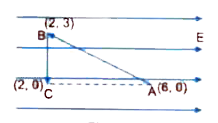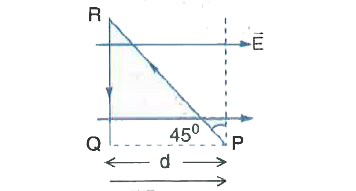A test charge q is moved without acceleration from A to C along the path from A to B and then from B to C in electric field E as shown in the figure.

Calculate the potential difference between A and C. Solution in Odia
Electric field intensity and potential difference are related as
or
or
Similar Questions
A test charge 'q' is moved without acceleration from A to C along the path from A to B and then from B to C in electric field E as shows in the figure. (i) Calculate the potential difference between A and C. (ii) At which point (of the two) is the electric potential more and why ?

View SolutionA test charge q_(0) A The path from C to C goes without acceleration as shown by ABC. The difference between A and C is
View SolutionA test charge q is moved without acceleration from A to C along the path from A to B and then from B to C in electric field E as shown in Fig. (i) Calculate the potential difference between A and C (ii) At what point [of A and C] is the electric potential more and why?

View SolutionA test charge q0 is moved without acceleration from P to Q in a uniform electric field over the path shown in figure. The points P and Q are seperated by a distance d. Find the potential difference between P and Q.

View Solutionआरेख (चित्र) में दिखाए अनुसार, किसी विद्युत् क्षेत्र E में, एक परीक्षण आवेश 'q' को बिना त्वरण के, पहले A से B तक और फिर B से C तक विस्थापित

किया जाता है। इस प्रकार आवेश 'q' के A से C तक जाने पर (i) A तथा C के बीच विभवान्तर के मान का परिकलन कीजिए। (ii) इन दो बिन्दुओं में से किस बिन्दु पर विद्युत विभव अधिक है ? अपने उत्तर के लिए कारण लिखिए।
View SolutionIn the electric field of a point charge ( + q) , placed at the centre of a circle , a certain test charge is carried from point A to B, C,D and E Least amount of work is done along the path
View SolutionIf a point charge +q is taken first from A to C and then from C to B of a circle drawn with another point charge +q as centre as shown in the figure, then along which path more than will be done.
View Solution
